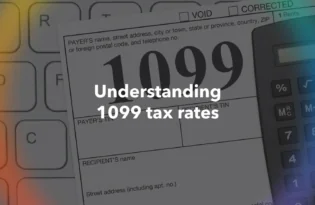Contractor vs self-employed: How are they different?
Learn more about how to classify independent contractor self employed workers. Know how each role differs in taxes, control, benefits, and much more.

Once you have started or expanded your business, it is time to look for fresh hires. But do you deduct taxes for everyone? Do you need to provide mandatory benefits to all employees?
This question comes up when you have multiple types of employees – from regular employees to non-employees like contractors or freelancers.
It is crucial to understand the employment nature of all employees to reduce any legal hassle. Every independent contractor is considered to be self-employed. But not every self-employed person is an independent contractor.
They can be freelancers or even gig workers. When you work with such non-employees, you must be aware of their legal compliance to mitigate any misclassification risks.
In this guide, we will brief you on independent contractors vs self-employed workers. You will come to know about the key differences between independent contractors and self-employed workers, how you can segregate the two, and much more.
Who is a self-employed person?
A self-employed person is someone who works for themselves and not for any employer. Any contracts do not bind them.
Who is an independent contractor?
An independent contractor is a person who works for either an individual or a company, typically based on signed contracts.
Understanding the classification: why is it important for you?
As an employer, understanding the classification between independent contractor self employed workers goes beyond technical importance. It is a legal necessity. You must be aware of this difference because it helps to:
- Protect your business from penalties for misclassification.
- Avoid any wage violations.
- Avoid improper tax withholding, since contractors are responsible for their tax filing.
- Build a professional relationship with your workers, based on transparency and trust.
Overlapping roles and misclassification
The terms ‘self-employed’ and ‘contractor’ may seem similar and are often used interchangeably. Self employment, independent contractor terms share a significant overlap in tax management, access to employee benefits, etc. These common areas include:
- The workers in both categories are not considered employees in an organization.
- They are fully responsible for their tax filing and management.
- They are solely responsible for arranging the necessary tools and equipment.
- Both the worker categories are entitled to company employee benefits.
- Invoice generation is the sole responsibility of the workers.
Despite these similarities, worker misclassification can lead to legal complications. The employer can face substantial penalties and damage to business relations. Understanding this overlap helps reduce such issues so that businesses can stay compliant.
Key differences between independent contractor – self-employed workers
Understanding the difference between self-employed workers and independent contractors helps you mitigate tax obligations and offer the mandatory benefits (if applicable by law).
Here’s how the two are different:
| Aspect | Self-employed individual | Independent contractor |
|---|---|---|
| Legal classification | It is a broader term for any worker who operates their own business, like a freelancer or a gig worker. | It is considered a non-employee who is contract-bound to provide services for another organization or individual. |
| Payment mode | Directly paid by the clients. | It is based on a contract or deliverables. |
| Tax filing | They will file an annual income tax return as a business owner by using Schedule C and Schedule SE. | Form 1099-NEC (in the U.S) is provided by each client. They will file Schedule C and pay their Self-Employment Tax. |
| Risks and liability | Responsible for the business risks. | Business risks are as per the terms of the contract; the parties may claim business insurance. |
| Audit risks | Risk is related to overall income reporting and deduction accuracy. | Risk is high if they’re misclassified by the company. |
Things to consider for proper employee classification
Now that you’re clear on the overlapping areas and key differences, here are a few pointers to keep in mind:
For self-employed individuals:
- They provide services to multiple clients at a time, not only to you.
- They can set and negotiate their own work terms.
- They have complete autonomy over how, when, and where they work.
- They will make independent business decisions.
- The employer does not need to provide any equipment or tools.
- They operate under their brand name.
For independent contractors:
- They are hired for a particular project.
- They will work under a contract that specifies deadlines and deliverables.
- They can not make fully independent business decisions without consulting the employer.
- They often work under the company’s name or the client’s brand.
- They may or may not use company tools, software, or equipment.
Examples from popular industries
Here are a few relevant examples to help clarify the self-employed vs. independent contractor debate.
Example 1:
An artist A is a full-time digital artist. They also own a business that ships personalized goodies to clients. They also share art snippets on multiple social media platforms for additional marketing.
Artist A is a self-employed person.
An artist B is working as a graphic designer on a commission basis. They design logos for web pages. They work with the client for three to six months, and the tenure varies with the contract.
Thus, artist B is an independent contractor.
Example 2:
Person X is a photographer. They have their team and work through their business website to gain clients. Once the job is completed, they share an invoice with the client to facilitate payment. Person X is a self-employed individual.
Person Y is also a photographer. They have a contractual agreement with the company ABC to work for one year. Every month, they share an invoice with the company for the hours spent at work and receive direct payments. Person Y is thus an independent contractor.
How can Payoneer Workforce Management help you?
Handling the legal liabilities of employees can be a tough job. It becomes more difficult if the employees fall into multiple categories. Not only would there be chances of employee misclassification, but you may also attract legal issues. This is where we come in.
Payoneer Workforce Management’s benefits include:
- Engage talent in 160+ countries.
- Onboard talent quickly and securely with localized contracts.
- Pay contractors seamlessly in 70 currencies.
- Get support to mitigate misclassification risks.
Book your demo today!
FAQs
1) Can I consider an independent contractor as my organization’s employee?
No, an independent contractor can not be considered as your organization’s employee. They are responsible for their own invoicing and tax filing. They are also not eligible for the company’s employee benefits.
2) How do I find reliable self-employed workers?
Here are some ways to hire reliable and professional self-employed workers:
- Search for skilled workers on professional networks like LinkedIn.
- Check on freelancer platforms.
- Post your requirements as a job listing on popular job search platforms.
- Use your professional network to contact trustworthy workers.
3) Can I set specific work hours for an independent self-employed contractor?
No, you can not. Independent self-employed contractors set their own work schedules. You can negotiate a project deadline, but you cannot dictate daily work timings.
Disclaimer
- Skuad Pte Limited (a Payoneer group company) and its affiliates & subsidiaries provide EoR, AoR, and contractor management services.
- The information in this article/on this page is intended for marketing and informational purposes only and does not constitute legal, financial, tax, or professional advice in any context. Payoneer and Payoneer Workforce Management are not liable for the accuracy, or reliability of the information provided herein. Any opinions expressed are those of the individual author and may not reflect the views of Payoneer or Payoneer Workforce Management. All representations and warranties regarding the information presented are disclaimed. The information in this article/on this page reflects the details available at the time of publication. For the most up-to-date information, please consult a Payoneer Workforce Management representative or account executive.
- Availability of cards and other products is subject to customer’s eligibility. Not all products are available in all jurisdictions in the same manner. Nothing herein should be understood as solicitation outside the jurisdiction where Payoneer Inc. or its affiliates is licensed to engage in payment services, unless permitted by applicable laws. Depending on or your eligibility, you may be offered the Corporate Purchasing Mastercard, issued by First Century Bank, N.A., under a license by Mastercard® and provided to you by Payoneer Inc., or the Payoneer Business Premium Debit Mastercard®, issued and provided from Ireland by Payoneer Europe Limited under a license by Mastercard®.
Related resources
Latest articles
-
How to hire employees in Australia
Looking to hire employees in Australia for your US company? Learn about employment in Australia and how Payoneer Workforce Management makes it easy to hire in Australia.
-
Planning to hire employees in Germany? Here’s a quick guide
Looking to hire employees in Japan for your U.S. company? Learn about hiring practices in Japan and how Payoneer Workforce Management makes it easy to hire in Japan.
-
Planning to hire employees in the Philippines? Here’s a quick guide
Wondering how an American company hires employees in the Philippines? Our guide covers how to hire employees in the Philippines and how we can help.
-
Planning to hire employees in Japan? Here’s a quick guide
Looking to hire employees in Japan for your U.S. company? Learn about hiring practices in Japan and how Payoneer Workforce Management makes it easy to hire in Japan.
-
Planning to hire in Hong Kong? Here’s a quick guide
Are you hiring employees in Hong Kong for your U.S. company? Learn about employment in Hong Kong and how Payoneer Workforce Management makes it easy to hire in Hong Kong.
-
Planning to hire in Colombia? Here’s a quick guide
Looking to hire employees in Colombia for your U.S. company? Learn about employment in Colombia and how Payoneer Workforce Management makes it easy to hire in Colombia.















